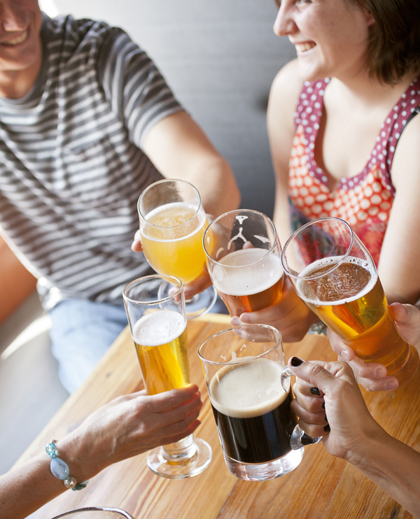In 2006, bigness was in style. It was the height of the extreme beer revolution, and though pale ales, IPAs and other classics remained the backbone of the craft brewing industry, America was burning in the high heat of extreme beer fever. Dogfish Head was just assuming national celebrity status, “imperial” renditions of almost all styles were emerging, the battle to brew the strongest beer was gaining ferocity, and high-alcohol beers aged in booze barrels were becoming the next exciting trend. Internet beer rating forums were expanding, and the favorite brews among many of the most active members were, almost inevitably, the big ones.
So when High & Mighty Beer Co.’s owner Will Shelton named his newly released ale “Beer of the Gods,” he plainly had his tongue in his cheek. For the beer, an American blonde, contained just 4.5 percent alcohol—sort of a brewing spoof on the trends of the time. But at least one person—beer devotee and explorer of styles Max Toste—took Beer of the Gods seriously. Toste was then rounding up an inventory to serve at his soon-to-be Boston beer bar, Deep Ellum, and when he opened doors in early 2007, the first beer that he put on tap was not an imperial chocolate stout, or a sour Belgian-style, or a barleywine aged in brandy barrels—but the modest little blonde named Beer of the Gods.

While some people may see "session" as a pejorative term, more brewers are starting to see it as a selling point.
“Frankly, I was sick of high-alcohol beers,” says Toste, who would soon add dozens more beers to his list. “I didn’t want to serve people something in a thimble and charge $9 for it. I wanted to serve people beer that they could drink 2 pints of and feel good about and not fall off their stool.”
The Multi-Pint Sit-In
Today, many others have joined in what seems to be a collective shift in interest away from extreme brew bigness and toward lesser, lighter styles—and Toste credits Beer of the Gods as the beer that sparked what may be a movement, and the return of the so-called “session beer.” By now, we’ve all heard the talk—the praise and appreciation for low-alcohol but flavorful beers conducive to all-day sipping and unlikely to get a person needlessly drunk. Many advocates of the category point out that session beers were once mainstays in Britain, where the active pub-going lifestyle was built long ago on light beers that allowed long, multi-pint sit-ins. In modern times, many of us drink at home—even while typing reviews into the keyboard—making “session” a challenging concept for many to embrace. The word is even a turnoff to some for its unhealthy implications of steady, daylong drinking. Shelton at High and Mighty says he never labels a beer as “session,” recognizing that many people see it a pejorative term.
But for some brewers, the word “session” is a selling point. Consider Notch Brewing, a Boston brand that has built itself on nothing but low-alcohol beers. To date, “The Notch” consists of three year-rounders and a rotation of seasonals, mostly traditional styles popular in Europe. Founder Chris Lohring, a veteran East Coast brewer who bottled and distributed his first Notch batch in March 2011, says the personal frustration of being unable to find low-alcohol American beers prompted him to brew his own.
“Almost nobody else was brewing the beers that I wanted to drink,” he says.
Lohring went commercial after conducting a few pub-special test batches and concluding that other people were also looking for downsized beers. Later, the roughly 4 percent ABV beers disappeared quickly from Boston-area outlets, like Craft Beer Cellar, home to some 600 craft beers by the bottle and can.
“We started selling (The Notch) the second it came out,” Suzanne Schalow, the shop’s co-owner, says. In the summer of 2011, the Notch pils became one of the shop’s top-five sellers, she says—and in the year since, demand for Lohring’s beers has grown steadily. He notes that in the past 18 months, five other Massachusetts breweries have introduced a session beer.









